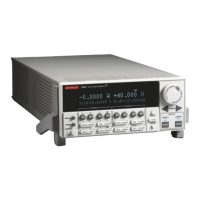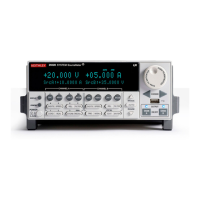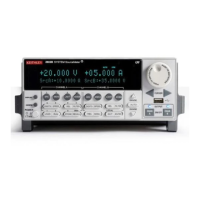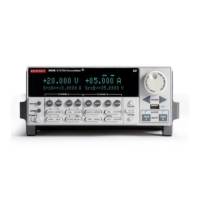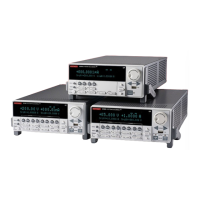3-10
SECTION 3
Bipolar Transistor Tests
To store the program in non-volatile memory, see the “TSP
Programming Fundamentals” section of the Series 2600 Refer-
ence Manual.
Once the code has been placed in the instrument run-time 8.
memory, we can run it at any time simply by calling the func-
tion ‘
AC _ Gain()
’. This can be done by typing the text
‘
AC _ Gain()
’ after the active prompt in the Instrument
Console line of TSB.
In the program ‘9. AC_Gain.tsp’, the function
AC _ Gain
(vcesource, ib1, ib2)
is created.
vcesource
• represents the voltage value on the
collector-emitter of the transistor
ib1
• represents the first value for the base current
ib2
• represents the second value for the base current
If these values are left blank, the function will use the default
values given to the variables, but you can specify each vari-
able value by simply sending a number that is in-range in
the function call. As an example, if you wanted to have the
collector-emitter voltage (V
CE
) be 2.5V, the base current initial
value at 100nA, and the base current second value at 200nA
you would send
AC _ Gain(2.5,100E-9, 200E-9)
to the
instrument.
Keep the two values as close together as possible so that the
device remains in its linear operating region. A change in I
B
of
about 20% from one value to another would be a good starting
point.
The sources will be zeroed and then enabled. The program 10.
will execute a two-point source and measure process.
Once the measurements have completed, the data (I11.
B1
, I
C1
,
I
B2
, I
C2
, and ß) will be presented in the Instrument Console
window of TSB.
3.5.13 Typical Program 7 Results
The differential current gain obtained for a given sample of a
2N5089 NPN transistor would typically be about the same as the
DC current gain—about 500. Again, values could range from a low
of 300 to a high of 800 or so.
3.5.14 Program 7 Description
After both units are returned to default conditions, SMUB is set
up as follows:
Source I•
IV compliance, 1.1V range•
Local sense•
SMUA is configured as follows:
Source V•
Local sense•
100mA compliance•
The collector-emitter voltage (V
CE
) will then be set. Then, the base
current will be set to the I
B1
value and the collector current (I
C1
)
will be measured. Next, the base current will be set to the I
B2
value and I
C2
will be measured. The AC current gain of the device
will then be calculated and printed to the Instrument Console
window of TSB.
3.5.15 Modifying Program 7
As with the DC current gain, AC current gain is often tested at
specific values of I
C
. Again, a search algorithm similar to the one
in Program 6A could be added to the program. Such an algorithm
would allow you to enter the desired collector current values, and
it would then perform an iterative search to determine automati-
cally the two correct base current values that would result in the
desired collector currents.
3.6 Transistor Leakage Current
Leakage currents, such as I
CEO
(collector-base, emitter open) and
I
CEO
(collector-emitter, base open) can be tested using a single-
channel System SourceMeter instrument. The following para-
graphs discuss I
CEO
tests and also include an example program for
making such tests.
3.6.1 Test Configuration
Figure 3-7 shows the basic test configuration for performing I
CEO
tests. The SMU sources the collector-emitter voltage (V
CEO
) and
the instrument also measures I
CEO
. Often, V
CEO
is swept across
the desired range of values, and the resulting I
CEO
values can be
plotted against V
CEO
, as is the case with the example program
included in this section.
The base of the transistor should be left open. The same general
circuit configuration can be used to measure I
CEO
; connect the
SMU between the collector and base, and leave the emitter open
instead.
Breakdown tests can also be performed using the same I
CEO
circuit
setup. In this case, the SMU is used to source I and measured
the breakdown voltage (V) in order to control device power at
breakdown better.

